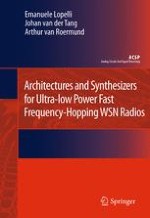2011 | OriginalPaper | Buchkapitel
2. System-Level and Architectural Trade-offs
verfasst von : Dr. Emanuele Lopelli, Dr. Johan van der Tang, Prof. Arthur van Roermund
Erschienen in: Architectures and Synthesizers for Ultra-low Power Fast Frequency-Hopping WSN Radios
Verlag: Springer Netherlands
Aktivieren Sie unsere intelligente Suche, um passende Fachinhalte oder Patente zu finden.
Wählen Sie Textabschnitte aus um mit Künstlicher Intelligenz passenden Patente zu finden. powered by
Markieren Sie Textabschnitte, um KI-gestützt weitere passende Inhalte zu finden. powered by
